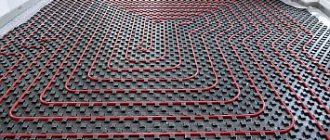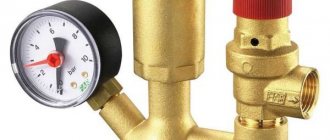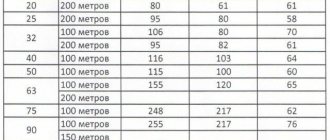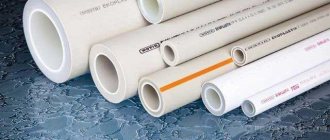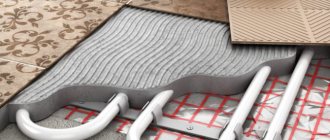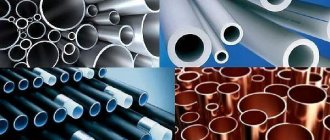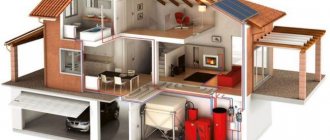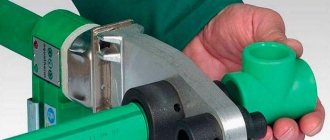If a decision is made to install a water-heated floor in a house, all the pros and cons for each material are usually carefully considered.
Is it worth installing a heated floor from metal-plastic pipes - is it profitable, is it reliable, and if so, how to do everything correctly with your own hands.
Characteristics of metal-plastic pipes
The high consumer properties of this type are due to the multilayer structure of the material. Its structure contains five layers: a load-bearing inner and outer protective layer of polymer, between which an aluminum core is built into adhesive layers (pictured).
Each layer performs its own functions that determine the parameters of the product.
The main characteristics of metal-plastic bends are the following:
- Operating temperature. The maximum value for metal-plastic is 110 degrees, while for water floors this value is 40 degrees.
- Operating pressure. The metal plastic can withstand a load of 10 atmospheres (about 10 bar) at 95. The limit for underfloor heating is 6 bar.
- Minimum bend radius. For the manual method it is 80 mm, using a tool - 45 mm.
- Passability measured by internal cross-section.
Cross-linked polyethylene
How to install heated floors under laminate Do it yourself
Thanks to modern technologies, such a seemingly fragile material as polyethylene has been made suitable for the production of pipes. In conventional polyethylene, hydrocarbon molecules are not connected to each other in any way, but in a new material (PEX, or cross-linked polyethylene), hydrocarbon molecules are connected through the interaction of hydrogen and carbon atoms. Additional high-pressure processing makes the material even more durable
The production of cross-linked pipes for underfloor heating has become widespread only recently, although the technology itself was developed approximately 40 years ago. The new material has characteristics that are not inherent in its predecessor. In particular, cross-linked propylene for heated floors is characterized by high mechanical strength, that is, it is not afraid of scratches and does not wear out, and is resistant to temperature fluctuations. Mainly, the properties of the material are affected by the technique and degree of crosslinking.
When deciding which cross-linked polyethylene to choose for a heated floor, you should pay attention to a material with a degree of cross-linking of 65-80%. This indicator will affect the strength and durability of the products, but at the same time, their price will also increase
True, unnecessary costs at the installation stage will pay off in the future due to the reliability and long service life of the pipes.
With a low degree of cross-linking, polyethylene will quickly lose its original qualities, crack under the influence of external factors and require replacement. However, no less important is the way in which molecular bonds are created.
There are 4 types of crosslinking:
- peroxide;
- silane;
- nitric;
- radiation.
When choosing which pipe to make a heated floor from, take a closer look at its markings. The highest quality is PEX-a, although it is the most expensive. But pipes marked PEX-b, cross-linked using the silane method, are in high demand. They have a relatively low price along with good performance properties.
This material also has other advantages, in particular:
- Ability to fully operate at temperatures from 0 ℃ to 95 ℃.
- Cross-linked polyethylene begins to melt only at a temperature of 150 ℃, and it burns at 400 ℃, so it can be successfully used in underfloor heating systems.
- Pipes made of cross-linked polyethylene are characterized by the so-called “molecular memory”, that is, after increasing the temperature of the material, any possible deformations are smoothed out, and the products themselves return to their original shape.
- The good resistance of cross-linked polyethylene products to pressure drops in heating systems is another argument in their favor when deciding which pipe to use for a heated floor. Depending on the characteristics, such pipes can maintain a pressure of 4-10 atmospheres.
- PEX pipes are characterized by good ductility, so even if they are repeatedly bent in the same place, they do not break.
- Cross-linked polyethylene is biologically and chemically resistant. This means that bacteria and fungus do not multiply on the inner surface of the pipes, and the material itself does not react with an aggressive environment and does not corrode.
- The chemical composition of cross-linked polyethylene is absolutely safe. It does not release toxins, and at the moment of combustion it breaks down into carbon dioxide and water.
Recommended operating temperatures for cross-linked polyethylene pipes are 0-95 ℃, but for a short time the range can expand to -50 - +150 ℃, and the material will not burst and will remain durable. However, such increased loads lead to a reduction in the service life of the material.
Some users confuse heat-resistant polyethylene pipes with PEX products. It is not correct. Indeed, heat-resistant polyethylene is capable of functioning at high temperatures, but in all other qualities it lags far behind cross-linked polyethylene. PEX pipes can resist aggressive external factors much longer, but their price is higher. And their installation does not require complex equipment and is accessible to every consumer.
So, if you are in doubt about what kind of pipes are needed for a heated floor, you can safely choose products made from cross-linked polyethylene. Moreover, their characteristics make it possible to use such pipes even for radiator heating and hot water supply. The only limitation is to minimize the exposure of the material to direct sunlight, although this is not relevant for heated floors.
In order not to damage the outer anti-diffusion layer on the pipes, their transportation and installation should be carried out very carefully. Violation of the integrity of the protective coating will lead to a decrease in the durability of the pipe due to oxygen entering the material structure.
Advantages and disadvantages
Consumers and professional craftsmen include the following advantages of metal-plastic channels:
- Good resistance to high temperatures, which resulted in their use in water floors.
- Easy and convenient to install, easier to work with.
- The plasticity of the material, the ability to maintain a given shape, pipes are easy to bend even by hand, which allows them to be laid in various configurations.
- Resistant to all types of corrosion.
- Much lower linear elongation.
- Lack of oxygen diffusion.
The disadvantages include:
- The difference in the coefficient of thermal expansion between polyethylene and aluminum, which over time leads to stratification of the channels.
- Significant bending radius, which is why creases occur if installed inaccurately.
- Loosening of fitting connections due to regular fluctuations in ambient temperature.
Flaws
Two layers of screed will significantly raise the floor level
. Like all other systems, water floors have disadvantages:
- complexity of installation;
- installation of a water pump is required to increase water pressure in horizontal pipes;
- reducing the height of the room due to several layers required for the installation of such a system;
- are not suitable for use in apartments, since such a system reduces the water pressure in the risers. For more information about the advantages and disadvantages of this design, watch this video:
Most often, a water floor is used for heating private houses, in which case it is fully justified in terms of durability and economic benefits.
It is best to involve specialists who will perform all the work, strictly adhering to installation technology. They will help you correctly calculate the consumption of materials and pipe laying pitch.
Kinds
In the construction of water floors, various types of pipe products are used: steel, copper, polypropylene, stainless steel, polyethylene. Today, metal-plastic pipes and REX (cross-linked polyethylene) pipes are ahead of their rivals and are competing with each other. Which of them is better is chosen by the consumer based on his interests and financial capabilities.
The performance qualities of metal-plastic pipes are determined by the following components:
- Type of polymer for the main and protective layers.
- Thickness of the aluminum reinforcing layer.
- Standard size of products.
These parameters distinguish products on the market today.
Of the polymer materials in modern models, cross-linked polyethylene PEX and its varieties - PEX-A, PEX-B, PEX-C, PEX-D - have proven themselves. The advantage of pex is its high strength and ability to return to its original shape after minor deformation.
Another polymer is PE-RT. It is heat resistant and can withstand temperatures up to +124C. The bends can be connected either by fittings or by welding, which is more reliable.
Products using HDPE (low-density polyethylene) are not very suitable for underfloor heating: at a temperature of 70° they are deformed.
How to install a collector group?
Whatever method of installing the heated floor you choose, in any case you will have to connect a cabinet for the collectors. After this installation, you need to connect the return and supply pipes to it. The second of them carries hot coolant, heated by the boiler. And already cooled water passes through the first pipe. It goes back to the heating unit, where it is again brought to the desired temperature. This ensures continuous circulation of water, provided by a special pump connected to the system.
It is best to mount the collector box in the center of the room. Moreover, this must be done as close as possible to the floor surface. This will make the system more efficient and economical.
Shut-off valves must be installed on both pipes. It will allow pipelines to be disconnected for repair work, if necessary. Metal-plastic pipe products and the valve are connected using a fitting. Then the collector is connected. An air vent is mounted on one side. A drain valve is installed on the second.
Watch the video:
Tips for choosing
When selecting material, the following factors are taken into account.
- The size of the budget allocated for the construction of a water floor. It should be borne in mind that this project will require much more pipes than the heating system in the house. An area of 20 m2 will require at least a bay of 100 linear meters of metal plastic.
- Convenience of installation. With products that are easier to bend, faster and easier to connect, there is less risk of getting a crease and a greater chance of making a reliable system.
- The strength, elasticity and thermal conductivity of pipes is determined by the thickness of the aluminum core. The thicker it is, the tighter the wiring. For self-installation, it is better to choose products with a reinforced layer of 0.15-0.2 mm.
- To install a water floor, bends with an internal diameter of 16 or 20 mm are purchased.
approximate price
Metal-polymer pipes are sold in cuts and coils. The cost is determined by the quality of the polymer, the cross-section size and the manufacturer.
Thus, metal-plastic products from the Italian company ICMA - 16 * 2 mm (PE/AL/PE-RT) cost 33 rubles per meter. Valtec products (Russia) 16*2 mm with PEX-B can be purchased for 60 rubles. Bends from the Italian company Uni-Fit PEX-b/PEX-c measuring 20*2 mm will cost 175 rubles.
How much pipe is needed for a heated floor?
To calculate the volume of material, the required heating power for specific areas, a suitable installation scheme, and laying step are determined. For the calculation, the established indicator is taken as a basis: 5 m of pipes are placed per 1 m2. The required number of linear meters is calculated using the formula:
L = S/N x 1.1
Here: S – coverage area; N – laying step; 1.1 – reserve for waste.
The length of the connection to the collector is also added here.
So, for a room of 12 square meters. m with a laying step of 0.15 m and a length from the floor to the collector of 3 m, we obtain:
12:0.15×1.1 +(3×2) = 94 m.
Calculator
On manufacturers' websites and in educational videos, you can use online calculator programs. It is enough to enter the initial data - room area, laying pitch, desired room temperature, type of screed, insulation, type and standard sizes of pipes - and the program will give the calculated heat flow power in watts per square meter. By changing the laying pitch and types of pipes, you can determine the optimal amount of heat flow.
Based on the calculated heat transfer, the amount of material required is calculated. As a rule, at a pitch of 200 mm, 5 meters of pipe are laid per square meter.
Pipe line marking
Before starting work, it is important to think about how the pipes will be placed. . When developing a scheme, it is advisable to:
When developing a scheme, it is advisable to:
- Draw pipeline lines directly on the walls of the room where it is planned to be laid, which helps visualize the structure.
- As a starting point, use the connection point of the pipe to the tap or radiator, which must already be installed before installation begins.
- Minimize the number of tees and crosses that affect pressure stability, and also minimize the number of other fittings.
- For corner laying of metal-plastic pipes, you can use a pipe bender or corner fittings.
- All connecting elements should be provided with free access, since threaded fasteners need periodic tightening to avoid leaks.
The installation of connecting elements must be carried out after completion of calculations and marking of the structure.
Methods for connecting metal-plastic pipes
The connecting installation of metal-plastic bends is carried out using two types of fittings:
- Compression.
- Press.
When laying flexible pipes they are generally not required. But when connecting to collectors and a number of other cases, you cannot do without them.
The compression method is much simpler and does not require tools other than an adjustable wrench.
Press fittings connect more reliably, but this connection is permanent.
Laying a metal-plastic heating system
Step 1. The first thing you need to do is purchase all the necessary materials and tools for installing water heating. That is, first of all, the metal-plastic pipes themselves, sold in large coils with a length of up to 50 m. In some cases, coils with a pipe length of 80 m can be purchased directly from the manufacturer. You will also need clamps for fixing the pipes on the reinforcing mesh, heat-reflecting material, the mesh itself, the required number of fittings to create connections between individual pipe sections, cement mixture for pouring the screed. It is best to buy pipes with a diameter of 16, 20 or 25 mm.
Preparing everything you need
Heated floor pipe circuit length calculator
Go to calculations
Step 2. Next, you need to prepare the rough foundation by laying waterproofing and insulating materials on it, as well as a reinforcing mesh with large cells. The individual mesh sheets are connected to each other using clamps. It is best to lay individual sheets so that they overlap each other by at least one cell. A damper tape must be glued along the walls, which is necessary to ensure that the poured concrete screed does not deform.
Laying reinforcing mesh
Step 3. After this, you need to select the correct location of the collector box. This is a very important indicator, since the pipe flow rate will depend primarily on the correct choice of location. You need to install the collector box itself.
Installation of the collector box
Step 4. Next you need to lay out the pipes according to the chosen pattern. They can be laid in a snake or in a spiral. In the first case, installation is usually done starting from the walls or windows. Laying in a spiral involves parallel arrangement of supply and return pipes - this is an option for spacious rooms, unlike the previous one
It is important to maintain the required pitch between the pipes. The laying step can vary and be 10, 15, 20 cm
Less commonly, it may be increased. Near the windows the step should be small - 15 cm.
There are several schemes for laying underfloor heating pipes. You can choose the right one based on your needs
Pipes are laid out according to the selected pattern
Another photo of the installation process
Step 5. In order to bend the pipe correctly, a pipe bending spring is used. It is put on the pipe itself and after that, adjusted to the required places, the desired radius is formed.
Using a bending spring
Step 6. The pipes must be fixed to the reinforcing mesh approximately every 1.5 m using plastic clamps. They should not be over-tightened, otherwise the pipes may be deformed during thermal expansion when heated.
Pipes are fixed on a reinforcing mesh
Step 7. After the pipe circuit has been laid and fixed, they need to be connected to the collector and the water supply checked. Then you can pour the screed directly on top of the pipes. But at this moment they should be filled with water. Otherwise, the pipes may bend.
The fixed circuit must be connected to the collector
Important! When installing a water floor heating system made of metal-plastic pipes, it is important to pay attention to the integrity of the material and the absence of damage or deformation. Otherwise, this will affect the quality of the final work.
And the total length of the pipes should not exceed 80-90 m. The best option is 50-60 m. If the total length of the pipes is greater, then two circuits should be installed, and the collector should have 2 outlets.
Do-it-yourself floor heating installation
The construction of a water floor as an auxiliary source of heating in a small room can be done independently, taking into account our recommendations. It is better to entrust a large amount of work to professionals.
To install on your own, you need to calculate the material, purchase it and prepare the tools.
Required tools and materials
The required materials include more than just pipes. You will need:
- Collector.
- Matching fittings.
- Damper tape.
- Fasteners.
- Materials for waterproofing and insulation.
- Components of a concrete mixture.
The tool is selected according to the type of work:
- Pipe bender or spring.
- Plastic scissors.
- Shovel, trowel, spatula, etc. for concrete work.
Drawings and diagrams
Water floor structure
Options for laying underfloor heating pipes
Installation technology
Pipe laying schemes suggest mainly two options: snake and snail.
The first one is considered simpler and more convenient to install. However, according to this scheme, hot water gradually cools down as it moves through the pipeline and it turns out that the temperature in one part of the circuit will be lower than in the other. The issue is resolved by installing a pump.
The option with a snail allows you to heat the circuit evenly. The method involves fewer bends, which is important for plastic with its possible creases.
Work progress
- First, the concrete base is leveled by all available means.
- Laying lines are marked taking into account the selected step, and fasteners in the form of clips are installed along them.
- Next, waterproofing and insulating materials are laid.
- A special tape is attached near the walls to protect the concrete pouring from cracks in the event of pipe deformation.
- Install the collector, place the ends of the bends there.
- Unwind and install the pipes along the marking lines, snapping them into clips.
- A special spring is used to bend the loops. It is put on the pipe and with its help the product is bent to the desired radius.
- Connect the pipes to the cabinet.
- The installed system is pressure tested by filling it with water under pressure.
- If the result is successful, begin pouring the screed.
Video - installation of a water floor
Installation features
Previously, polystyrene foil was laid as a thermal insulation layer. Now profile slabs made of polystyrene foam have appeared, equipped with special bosses for easy installation of flexible pipes.
In cases where it is not possible to make a screed, a slatted floor is installed. The bars are fastened between the turns and the floor covering is laid on them.
Installation Tools
- Pipe bender or spring jig.
- A cutter (a tool that resembles pliers) helps to make a clear, strictly perpendicular cut without dents or bevels. If it is not possible to purchase a cutter, use a sharp construction knife, but under no circumstances a hacksaw (it leaves a torn cut with many burrs).
- Calibrator (a cross-shaped tool with ends of different sizes for different diameters).
- Open-end wrenches.
- Sandpaper.
- Press jaws. Easy and quick installation with press fittings. Special pressing pliers are used to crimp them. There is also an electric press tool (a gearbox increases the pressing force to several tons), it is classified as professional equipment and is expensive.
Water-heated floors in a private home are the best option for creating a comfortable indoor microclimate. Do-it-yourself warm water floor - design and installation features.
What kind of warm floor is suitable for laminate, read in this topic.
We will consider options for installing heated floors in a private house here:. Installation with or without screed.
Maintenance Tips
Underfloor heating systems rarely fail. But to prevent this from happening unexpectedly, you should regularly check the fittings and pump that serve the wiring.
If air gets into the system, you will have to carry out pressure testing using a pressure tester, which you can rent for a while, or invite a specialist with this equipment.
You should carefully monitor the temperature. A value exceeding the manufacturer’s value significantly reduces the service life of the metal sheet.
How to eliminate a leak in a structure
A leak is detected by wet spots on the floor or a drop in coolant in the circuit.
You must immediately turn off the water supply and turn off the pump.
The coolant is drained through the drain valve.
At the leak site, remove the layer of concrete with a hammer drill.
Cut out the damaged section and attach a new piece of elbow in its place using two fittings.
After completion of the repair, the system’s functionality is checked and the screed is restored.
Expansion joint
Unfinished expansion joints often lead to cracks and deformations of the screed. You should know in what cases shrinkage seams are made:
- floor covering area exceeds 30 m2;
- the walls of the room are longer than 8 m;
- if the walls in the room are disproportionate, the value of the length and width differs by half;
- above expansion joints in the coating structure;
- the room has many curves.
Expansion joints of concrete floors
A damper tape is glued along the perimeter of the joint. The reinforcement frame above the seam is also disconnected. The thickness of the seam is 10 mm at the base. The upper part is treated with sealant.
Pipes where they pass over expansion joints are laid in corrugation. Two circuits must pass side by side above the seam: coolant supply and return.
Advice. If tiles serve as the floor covering, then where the expansion joint passes, it may peel off due to uneven expansion of adjacent slabs. In this case, part of the tile is placed on tile adhesive, and an elastic sealant is applied to the other half.
